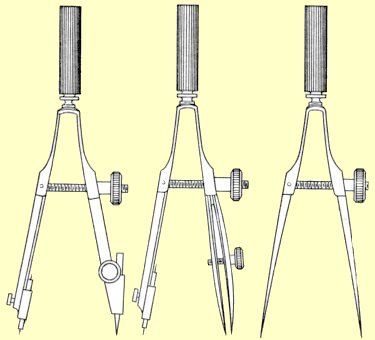Drafting
Today, a skill eliminates itself. The University of Houston's College of Engineering presents this series about the machines that make our civilization run, and the people whose ingenuity created them.
I found this dusty wordless book in our library -- not one word! The title, in fine Victorian print, says Descriptive Geometry: Plates. It holds a hundred and thirty two carefully worked exercises in mechanical drawing, nothing more. It was the companion of a long forgotten textbook. It shows how to draw perspective views of intersecting arched hallways -- how to lay out the sheet-metal pattern of the skewed frustum of a skewed cone.

In 1931, West Point cadet Harold Hughes signed this copy. Yet the book had been in print since the Civil War. It displayed constructions first devised by the great renaissance artist Albrecht Dürer. In the intervening half millennium, good drafting books (like this one) have often had that kind of staying-power.
If you're an older engineer, there's a good chance you learned drafting from a book by Thomas French. It came out in 1911. French died in 1944, and revisions of his book are still in print. But the subject has migrated from paper into our computers. If French came back today, he wouldn't recognize his fourteenth edition.
Last week, a colleague gave me a 1904 text by a Tufts professor. This one stayed in use over twenty years -- until French's book replaced it. It's shorter, but the whole story is there. Here's the same lost tactile world of drafting that I entered in 1946. First, the tools: T-square, triangles, a scale (which is never to be called a ruler), 4H and 6H Siberian-lead pencils and sandpaper to sharpen them, a set of French curves, and thumb tacks (the 3-M Company has yet to invent masking tape.) We also have to invest in a case of instruments -- compasses, dividers, ruling pens -- and in a bottle of India ink.
Next, we relearn lettering. A proper draftsman leaves the cursive script of public schools behind forever. We learn to draw a straight line in pencil, and ink it in with thin lines or thick ones.

But all this is prelude. Now we learn to reduce vision to a vocabulary of lines -- solid lines that we can see with our eyes, hidden lines that we can see only in our mind. We learn to turn objects about in space, but to do it on two-dimensional paper.
These old books leave me with an aching sense of lost beauty. I still have my old tools, but the computer has grown too large. The old drawing skills shrink before it. In 1952, when I taught advanced drafting to newly hired engineers at Boeing, new technologies were already hinting at the end of an era.
Now I hold these old books -- written before the computer, even before Thomas French. If you focus upon their brief contents, you too can do what Albrecht Dürer did: Stand at the drafting board and watch ideas flow from under your ink-stained fingers. You too can own space and bring forth machines. But watch out! Once you do, you will create a computer-driven, electronically lit world, where these old skills can no longer have any place.
I'm John Lienhard, at the University of Houston, where we're interested in the way inventive minds work.
(Theme music)
Church, A. E., Plates to Descriptive Geometry: Shades, Shadows and Linear Perspective. New York American Book Company, 1864/1892
French, T. E., and Ives, F. W., Agricultural Drawing and the Design of Farm Structures. New York: McGraw-Hill Book Company, Inc., 1915.
French, T. E., A Manual of Engineering Drawing for Students and Draftsmen. 4th ed., McGraw-Hill Book Co., Inc., 1911, 1918, 1924, 1929. (This is the edition on my desk. Amazon.com is presently (2001) showing the fourteenth edition for sale. My fourth edition indicates that 308,000 copies had been sold by 1929.)
Anthony, G. C., Elements of Mechanical Drawing: The Use of Instruments; Theory of Projections and its Application to Practice; and Numerous Problems Involving both Theory and Practice. Boston: D. C. Heath & Co., Publishers, 1894/1904. (I am grateful to Joseph Davidson, Language and Culture Center, UH, for this edition of the Anthony book.)
